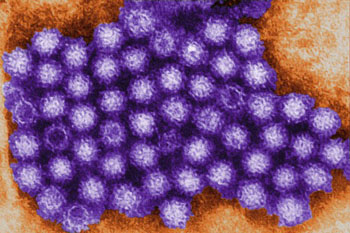Researchers Identify Cell Surface Protein Required for Norovirus Infection
By LabMedica International staff writers
Posted on 31 Aug 2016
Molecular virologists working with a mouse norovirus strain identified and characterized a cell surface protein that was required by the virus to gain entry into the host cell.Posted on 31 Aug 2016
Noroviruses (NoVs) are a leading cause of gastroenteritis globally, yet the host factors required for NoV infection are poorly understood. Human norovirus will not infect any of the species typically used in biomedical research, such as mice, rats, or rabbits nor will it grow in human cell cultures.

Image: A colored transmission electron micrograph (TEM) of norovirus (Photo courtesy of Charles D. Humphrey, CDC).
Investigators at the Washington University School of Medicine (St. Louis, MO, USA) chose to work with mouse norovirus, which would allow them to perform experiments to better understand the factors required for infection of an animal by the virus. To this end they used CRISPR/Cas9 gene editing to identify mouse genes that were important for mouse noroviral infection.
CRISPRs (clustered regularly interspaced short palindromic repeats) are segments of prokaryotic DNA containing short repetitions of base sequences. Each repetition is followed by short segments of "spacer DNA" from previous exposures to a bacterial virus or plasmid. CRISPRs are found in approximately 40% of sequenced bacteria genomes and 90% of sequenced archaea. CRISPRs are often associated with cas genes that code for proteins related to CRISPRs. Since 2013, the CRISPR/Cas system has been used in research for gene editing (adding, disrupting, or changing the sequence of specific genes) and gene regulation. By delivering the Cas9 enzyme and appropriate guide RNAs (sgRNAs) into a cell, the organism's genome can be cut at any desired location. The conventional CRISPR/Cas9 system is composed of two parts: the Cas9 enzyme, which cleaves the DNA molecule and specific RNA guides that shepherd the Cas9 protein to the target gene on a DNA strand.
The CRISPR/Cas9 study, which was published in the August 18, 2016, online edition of the journal Science, revealed that the mouse protein receptor CD300lf was essential for mouse NoV binding and replication in cell lines and primary cells. Additionally, mice that lacked the gene for Cd300lf were resistant to mouse NoV infection. Expression of mouse CD300lf in human cells enabled the mouse norovirus to infect the human cells.
“Mouse norovirus grew just fine in human cells,” said senior author Dr. Herbert Virgin, professor of pathology and immunology at the Washington University School of Medicine. “This tells us that the species restriction is due to the ability to get inside the cells in the first place. Once inside the cells, most likely all the other mechanisms are conserved between human and mouse noroviruses, since the viruses are so similar.”
“Our inability to grow the virus in the lab has limited our ability to develop anti-viral agents. If you can’t get the virus to multiply in human cells, how are you going to find compounds that inhibit multiplication?” said Dr. Virgin. “This discovery provides a good basis for our mouse model, which we can then use to understand noroviral pathogenesis and search for treatments in people.”
Related Links:
Washington University School of Medicine













